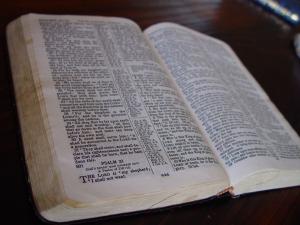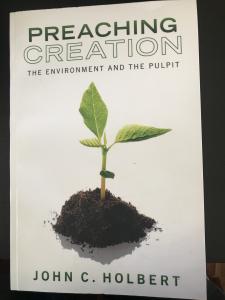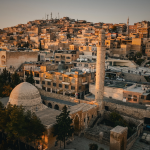(Lectionary for September, 17, 2017)
The very first time I visited Israel, now 40 years ago, our guide was a veteran tank commander of the Israeli army, who, not many years before, had led his forces into battle on the Golan Heights against one of Israel’s many enemies at the time. He regaled us with a brutal account of that battle as we American tourists gazed at the Golan just over our shoulders. We were at that moment standing at the traditional site of Jesus’ Sermon on the Mount, a shrine festooned with a large plaque proclaiming, “Blessed are the Peacemakers.” Irony dripped, as you may imagine.
This same man was currently pursuing a PhD in archaeological studies at a nearby university, and I asked him about the subject of his dissertation, having just completed one of my own in Hebrew Bible studies a couple of years before. He said that he was attempting to locate the actual site of the Israelite crossing at the sea, traditionally called the Red Sea, but which the Hebrew text more literally names the “Sea of Reeds.” I was quite taken aback by his study, since it had been made clear to me by all of my teachers, and I had come to accept it as well, that the exact location was either no longer recoverable, or, for some scholars, was never an actual location in the first place. I now stand with the latter group. The narrative about what is clearly the Israelite resurrection story is just that—a story, a tale designed to anchor the faith and convictions of those who ascribe to it, not in some murky historical past, but in the grandeur of an unforgettable story, one that can be told and retold down the ages, as it surely has been. I shared my ideas about all this with Shmuel, but he was having none of it. Politely, he told me that I was quite wrong and misguided; the spot at the sea was out there somewhere in the Sinai desert, and he intended to find it. I wished him well, but silently felt his search was doomed from the start. In the ensuing 40 years, I have heard nothing of any startling finds, though many Israelis, not to mention vast numbers of evangelical Christians, are convinced that these stories are finally fully historical. I cannot agree.
In today’s text there are in fact two stories of the event that have been rather raggedly woven together into the final text we have before us. One describes a tidal event, wherein “YHWH drove the sea back by a strong east wind all night, and turned the sea i nto dry land” (Ex. 14:21a). The picture seems clear enough. Moses raise his hand over the sea, and the usual tide of the waters occurs over the ensuing hours, “all night.” The result is “ dry land,” the same “dry land” that appears in Gen. 1:9’s account of the world’s creation, as the “waters are gathered together into one place” in order that the dry land would appear. The miracle at the see is first announced to us as a reiteration of the world’s creation by God.
nto dry land” (Ex. 14:21a). The picture seems clear enough. Moses raise his hand over the sea, and the usual tide of the waters occurs over the ensuing hours, “all night.” The result is “ dry land,” the same “dry land” that appears in Gen. 1:9’s account of the world’s creation, as the “waters are gathered together into one place” in order that the dry land would appear. The miracle at the see is first announced to us as a reiteration of the world’s creation by God.
Then Ex.14:21b adds “and the waters were divided.” But this makes little sense. If the tide moves back to reveal dry land, it is hardly the case that the waters have been divided. This is certainly another account of the event, that particular account made forever famous by Cecil B. DeMille’s epic “The Ten Commandments,” believe or not, by the judicious use of jello! No computer generated imagery available in those days, so household creativity saved the day. But DeMille’s portrait is only one of the stories being relayed to us here. “The Israelites went into the sea on dry land, the waters forming a wall for them on right and left” (Ex. 14:22). The second part of that verse could be an emphasis on the instantaneous walls of water image of the previous verse, or it may be a continuous picture of the first part of vs.22, the picture being the tiny group of Israelites venturing into the dry land made so by the magic walls of water, a la DeMille. Then in vs.23 the Egyptians pursue after them, all pharaoh’s chariots, horsemen, and chariot drivers.
Ex.14:24 returns us to the longer event, as “at the morning watch, YHWH in the pillar of fire and cloud looked down on the Egyptian army, and threw the Egyptians into a panic.” This is precisely what YHWH does to the armies of Sisera in the very ancient Judges 5 story of the struggle between Deborah, Barak, and the forces of the Canaanites. There is divine magic and mystery here that results in enemy confusion to follow. Unfortunately, the text here is just as confused as the Egyptian army! It says literally, “YHWH removed the wheels of their chariots, so that they drove with heaviness” (the NRSV translates the verb “removed”, using several other versions of the text, “clogged, but the Hebrew appears to be clear). Whether one reads removed or clogged, the chariots must be abandoned, and as the Egyptians rush around in complete disarray, they cry, “Let us flee from the Israelites for YHWH is fighting for them against the Egyptians” (Ex.14:25). It is a common feature of the battle texts of the Hebrew Bible to have the enemy recognize and proclaim that YHWH is the real fighter against them.
Now YHWH speaks again to Moses, “Stretch out your hand over the sea, so that the water may come back upon the Egyptians, upon their chariots and drivers” (Ex.14:26). And Moses does, “and at dawn the sea returned to its normal depth” (Ex.14:26). Again, we return to the slower event, the tidal one; the sea returns to normal aft er the all-night tide. The proper translation of the nest part of vs.27 is important. The text says, “The Egyptians fled to meet it, and YHWH tossed the Egyptians into the sea.” In other words, the Egyptian warriors in their panic and confusion, bereft of their chariots, wheels either removed or clogged, flee directly into the sea, the final clause making it clear that that was YHWH’s intent. “The waters returned and covered the chariots and chariot drivers, the entire army of pharaoh,…not one of them remained” (Ex.14:28). The portrait is that as the tide returns, instead of fleeing from the tide, the Egyptians instead rush toward the returning tide and drown in the sea. Then 14:19 returns the reader to the immediate story as the waters of the sea are again said to from walls of water on right and left.
er the all-night tide. The proper translation of the nest part of vs.27 is important. The text says, “The Egyptians fled to meet it, and YHWH tossed the Egyptians into the sea.” In other words, the Egyptian warriors in their panic and confusion, bereft of their chariots, wheels either removed or clogged, flee directly into the sea, the final clause making it clear that that was YHWH’s intent. “The waters returned and covered the chariots and chariot drivers, the entire army of pharaoh,…not one of them remained” (Ex.14:28). The portrait is that as the tide returns, instead of fleeing from the tide, the Egyptians instead rush toward the returning tide and drown in the sea. Then 14:19 returns the reader to the immediate story as the waters of the sea are again said to from walls of water on right and left.
I hope I have demonstrated the rich complexity of this famous tale, or should I rather say tales. There is a victory at sea here, though the memory of the story divides into two accounts. Whichever account one finds embedded here, and whichever is the older of the two, the impact is precisely the same: on the west bank of the sea Israel is a slave of Egypt, but on the east bank they are now fully the people of YHWH. Sorry, Shmuel, my friend, you will never find “where” this happened. That is not the point. It is a narrative, a crucial story that binds Israel together into the larger and ongoing story of God. Could we Christians learn from this story that our own Christian “history” is also a story, not to be fought over as history but to be embraced as a lens through which to view the life of the universe? I would hope so.











